Nup98 FG domains from diverse species spontaneously phase-separate into particles with nuclear pore-like permselectivity
- PMID: 25562883
- PMCID: PMC4283134
- DOI: 10.7554/eLife.04251
Nup98 FG domains from diverse species spontaneously phase-separate into particles with nuclear pore-like permselectivity
Abstract
Nuclear pore complexes (NPCs) conduct massive transport mediated by shuttling nuclear transport receptors (NTRs), while keeping nuclear and cytoplasmic contents separated. The NPC barrier in Xenopus relies primarily on the intrinsically disordered FG domain of Nup98. We now observed that Nup98 FG domains of mammals, lancelets, insects, nematodes, fungi, plants, amoebas, ciliates, and excavates spontaneously and rapidly phase-separate from dilute (submicromolar) aqueous solutions into characteristic 'FG particles'. This required neither sophisticated experimental conditions nor auxiliary eukaryotic factors. Instead, it occurred already during FG domain expression in bacteria. All Nup98 FG phases rejected inert macromolecules and yet allowed far larger NTR cargo complexes to rapidly enter. They even recapitulated the observations that large cargo-domains counteract NPC passage of NTR⋅cargo complexes, while cargo shielding and increased NTR⋅cargo surface-ratios override this inhibition. Their exquisite NPC-typical sorting selectivity and strong intrinsic assembly propensity suggest that Nup98 FG phases can form in authentic NPCs and indeed account for the permeability properties of the pore.
Keywords: C. elegans; D. melanogaster; Nup100; Nup116; S. cerevisiae; Tetrahymena; arabidopsis; biochemistry; cell biology; human; importin; nucleocytoplasmic transport; nucleoporin.
Conflict of interest statement
The authors declare that no competing interests exist.
Figures

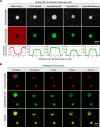


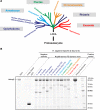



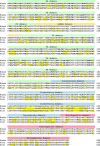


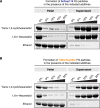



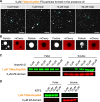


Similar articles
-
Systematic analysis of barrier-forming FG hydrogels from Xenopus nuclear pore complexes.EMBO J. 2013 Jan 23;32(2):204-18. doi: 10.1038/emboj.2012.302. Epub 2012 Nov 30. EMBO J. 2013. PMID: 23202855 Free PMC article.
-
The permeability of reconstituted nuclear pores provides direct evidence for the selective phase model.Cell. 2012 Aug 17;150(4):738-51. doi: 10.1016/j.cell.2012.07.019. Cell. 2012. PMID: 22901806
-
A saturated FG-repeat hydrogel can reproduce the permeability properties of nuclear pore complexes.Cell. 2007 Aug 10;130(3):512-23. doi: 10.1016/j.cell.2007.06.024. Cell. 2007. PMID: 17693259
-
The selective permeability barrier in the nuclear pore complex.Nucleus. 2016 Sep 2;7(5):430-446. doi: 10.1080/19491034.2016.1238997. Epub 2016 Sep 27. Nucleus. 2016. PMID: 27673359 Free PMC article. Review.
-
Biomechanics of the transport barrier in the nuclear pore complex.Semin Cell Dev Biol. 2017 Aug;68:42-51. doi: 10.1016/j.semcdb.2017.05.007. Epub 2017 May 12. Semin Cell Dev Biol. 2017. PMID: 28506890 Review.
Cited by
-
Biophysical and biochemical properties of Deup1 self-assemblies: a potential driver for deuterosome formation during multiciliogenesis.Biol Open. 2021 Mar 3;10(3):bio056432. doi: 10.1242/bio.056432. Biol Open. 2021. PMID: 33658185 Free PMC article.
-
Crystal structures of FNIP/FGxxFN motif-containing leucine-rich repeat proteins.Sci Rep. 2022 Sep 30;12(1):16430. doi: 10.1038/s41598-022-20758-8. Sci Rep. 2022. PMID: 36180492 Free PMC article.
-
Crowding-induced phase separation of nuclear transport receptors in FG nucleoporin assemblies.Elife. 2022 Jan 31;11:e72627. doi: 10.7554/eLife.72627. Elife. 2022. PMID: 35098921 Free PMC article.
-
Exploring Relationships between the Density of Charged Tracts within Disordered Regions and Phase Separation.Pac Symp Biocomput. 2020;25:207-218. Pac Symp Biocomput. 2020. PMID: 31797598 Free PMC article.
-
Barrier properties of Nup98 FG phases ruled by FG motif identity and inter-FG spacer length.Nat Commun. 2023 Feb 10;14(1):747. doi: 10.1038/s41467-023-36331-4. Nat Commun. 2023. PMID: 36765044 Free PMC article.
References
Publication types
MeSH terms
Substances
LinkOut - more resources
Full Text Sources
Other Literature Sources
Molecular Biology Databases

